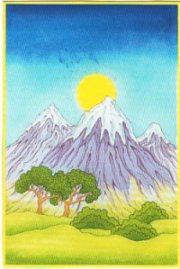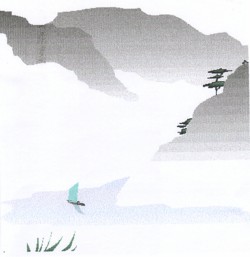All the therapies and techniques described on these pages are ones I have experienced myself, and while descriptions of techniques are factual, all opinions are personal.
All the therapies and techniques described on these pages are ones I have experienced myself, and while descriptions of techniques are factual, all opinions are personal.

Creative Visualisation is a technique which is used by several different therapies as an aid to healing or self-discovery. It can be done alone, or as a guided meditation in a group, or one-to-one with a therapist.
The subconscious expresses itself in images rather than words (as in dreams) and the idea behind Creative Visualisation is to reach into the subconscious and access what is going on there. In a guided meditation, the therapist or facilitator will suggest general surroundings - for instance a scene, a journey - but what specifically happens within the meditation depends on the person doing it. For example: the facilitator may say, "You are on a road through the woods. You reach a stream and cross it..." It is entirely up to each person meditating whether he or she sees the woods as dark and threatening, or as bright and sunny; whether the stream is shallow or deep and fast-flowing; whether the water is crossed by splashing into it, by stepping-stones, or by finding a boat. There may later be the suggestion that "you meet somebody who offers you a gift..." but who or what the person is, and the nature of the gift (and whether you accept it or not) is up to you! It is simply a way of visiting your subconscious and finding out what is going on there; what attitudes you unconsciously hold; and as such can be a valuable tool.
Any creative visualisation must be brought to a proper closure. The journey should always be retraced in order to return to the conscious level. If the meditation is being done in a group, what each person has found may be discussed, or not, as wished by each individual.
A simple Creative Visualisation is given below, for you to try if you wish. Some people find it difficult to think in images, but this usually comes with practice. One warning: creative visualisation is a tool, not a way of life! Just as computer games (which are often couched in archetypes) can become addictive, so can delving into your subconscious. It is counterproductive (and unhealthy) to use this type of technique too often, and as an escape from the real and external world. The object of the exercise is to bring greater understanding back to your conscious world, and to be a whole and self-aware person.
Some people find it difficult to think in images, but this usually comes with practice. One warning: creative visualisation is a tool, not a way of life! Just as computer games (which are often couched in archetypes) can become addictive, so can delving into your subconscious. It is counterproductive (and unhealthy) to use this type of technique too often, and as an escape from the real and external world. The object of the exercise is to bring greater understanding back to your conscious world, and to be a whole and self-aware person.
Visualise a street. In front of you there is an old-fashioned pharmacy. In the wide plate-glass window stand three giant bottles, round-bodied, with stoppers on the top. Each of them is filled with a coloured liquid. Perhaps one is a vivid red, another a deep blue, the third a glowing green. Or one may be amber-yellow, or dynamic orange, or imperial purple - your mind will supply the colours.
Approach the window. Pass through the glass. Step through into one of the bottles. Allow your choice to be instinctive: that will be the colour you need today. Let the colour surround you. Bathe in it. Feel it encompassing you and passing through you. Float suspended in it. You are in a safe, protected world whose vivid shade is there to soothe or invigorate you.
It is for you to choose how long you stay there - a long or a short time - and when you feel you have been there long enough, you can step gently out again, out through the bottle, out through the glass window, back into the street. And then back into your conscious life. Draw several deep breaths to bring yourself back into the present reality.
The colour you have bathed in will have healed something in you.
If you are interested in Image work, the following are books you could consult:
"Life Choices and Life Changes Through Imagework" by Dina Glouberman
"What We May Be, The Visions and Techniques of Psychosynthesis" by Piero Ferrucci
"Psychosynthesis in Education" by Diana Whitmore
"Gestalt Therapy Verbatim" by Fritz Perls (specifically, the part on Talking to Dreams)
Back to Index